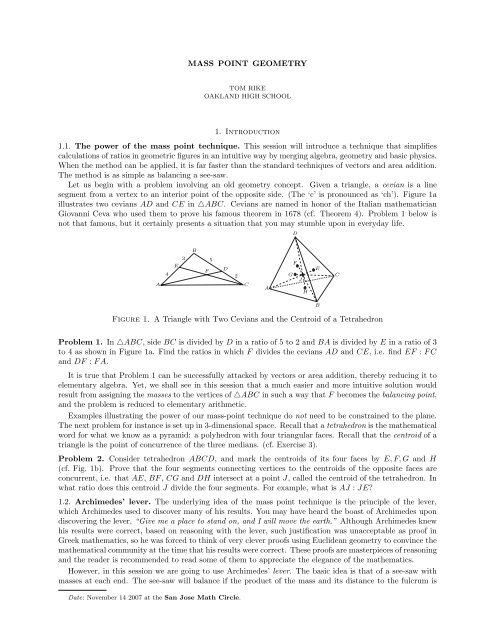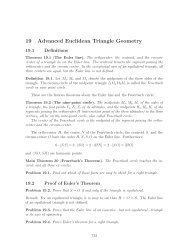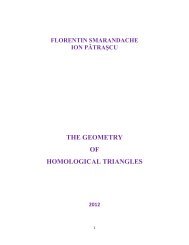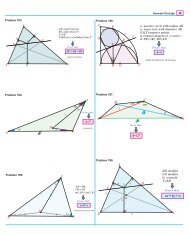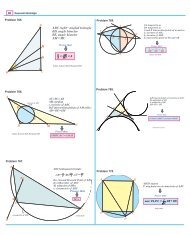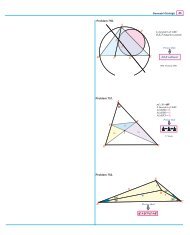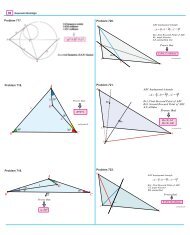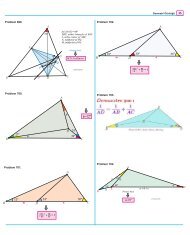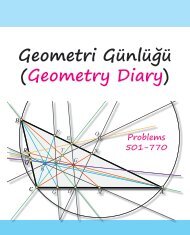20071114
Create successful ePaper yourself
Turn your PDF publications into a flip-book with our unique Google optimized e-Paper software.
MASS POINT GEOMETRY<br />
TOM RIKE<br />
OAKLAND HIGH SCHOOL<br />
1. Introduction<br />
1.1. The power of the mass point technique. This session will introduce a technique that simplifies<br />
calculations of ratios in geometric figures in an intuitive way by merging algebra, geometry and basic physics.<br />
When the method can be applied, it is far faster than the standard techniques of vectors and area addition.<br />
The method is as simple as balancing a see-saw.<br />
Let us begin with a problem involving an old geometry concept. Given a triangle, a cevian is a line<br />
segment from a vertex to an interior point of the opposite side. (The ‘c’ is pronounced as ‘ch’). Figure 1a<br />
illustrates two cevians AD and CE in △ABC. Cevians are named in honor of the Italian mathematician<br />
Giovanni Ceva who used them to prove his famous theorem in 1678 (cf. Theorem 4). Problem 1 below is<br />
not that famous, but it certainly presents a situation that you may stumble upon in everyday life.<br />
D<br />
B<br />
A<br />
4<br />
E<br />
3 5<br />
F<br />
D<br />
2<br />
C<br />
A<br />
F<br />
G<br />
J<br />
H<br />
E<br />
C<br />
B<br />
Figure 1. A Triangle with Two Cevians and the Centroid of a Tetrahedron<br />
Problem 1. In △ABC, side BC is divided by D in a ratio of 5 to 2 and BA is divided by E in a ratio of 3<br />
to 4 as shown in Figure 1a. Find the ratios in which F divides the cevians AD and CE, i.e. find EF : F C<br />
and DF : F A.<br />
It is true that Problem 1 can be successfully attacked by vectors or area addition, thereby reducing it to<br />
elementary algebra. Yet, we shall see in this session that a much easier and more intuitive solution would<br />
result from assigning the masses to the vertices of △ABC in such a way that F becomes the balancing point,<br />
and the problem is reduced to elementary arithmetic.<br />
Examples illustrating the power of our mass-point technique do not need to be constrained to the plane.<br />
The next problem for instance is set up in 3-dimensional space. Recall that a tetrahedron is the mathematical<br />
word for what we know as a pyramid: a polyhedron with four triangular faces. Recall that the centroid of a<br />
triangle is the point of concurrence of the three medians. (cf. Exercise 3).<br />
Problem 2. Consider tetrahedron ABCD, and mark the centroids of its four faces by E, F, G and H<br />
(cf. Fig. 1b). Prove that the four segments connecting vertices to the centroids of the opposite faces are<br />
concurrent, i.e. that AE, BF , CG and DH intersect at a point J, called the centroid of the tetrahedron. In<br />
what ratio does this centroid J divide the four segments. For example, what is AJ : JE?<br />
1.2. Archimedes’ lever. The underlying idea of the mass point technique is the principle of the lever,<br />
which Archimedes used to discover many of his results. You may have heard the boast of Archimedes upon<br />
discovering the lever, “Give me a place to stand on, and I will move the earth.” Although Archimedes knew<br />
his results were correct, based on reasoning with the lever, such justification was unacceptable as proof in<br />
Greek mathematics, so he was forced to think of very clever proofs using Euclidean geometry to convince the<br />
mathematical community at the time that his results were correct. These proofs are masterpieces of reasoning<br />
and the reader is recommended to read some of them to appreciate the elegance of the mathematics.<br />
However, in this session we are going to use Archimedes’ lever. The basic idea is that of a see-saw with<br />
masses at each end. The see-saw will balance if the product of the mass and its distance to the fulcrum is<br />
Date: November 14 2007 at the San Jose Math Circle.
2 TOM RIKE OAKLAND HIGH SCHOOL<br />
the same for each mass. For example, if a baby elephant of mass 100 kg is 0.5 m from the fulcrum, then<br />
an ant of mass 1 gram must be located 50 km on the other side of the fulcrum for the see-saw to balance<br />
(cf. Fig. 2, not drawn to scale): distance × mass = 100 kg × 0.5 m = 100, 000 g × 0.0005 km = 1 g × 50 km.<br />
E F<br />
| {z } | {z }<br />
A<br />
0.5 m 50 km<br />
Figure 2. Balancing on a See-saw: Elephant and Ant<br />
(artwork by Zvezda)<br />
As we shall see, the uses of the lever are more far-reaching than one might imagine. For instance, here is<br />
another problem for you to consider. It extends our mass point technique to transversals: a transversal of<br />
lines l and m is a line that joins a point on l and a point on m. Note that a transversal of two sides in a<br />
triangle is a generalization of what we defined earlier as a cevian.<br />
Problem 3. In Figure 3, ED joins points E and D on the sides of △ABC forming a transversal. Cevian<br />
BG divides AC in a ratio of 3 to 7 and intersects the transversal ED at point F . Find the ratios EF : F D<br />
and BF : F G.<br />
A<br />
4<br />
E<br />
3<br />
3<br />
G<br />
B<br />
F<br />
Figure 3. A Transversal Problem<br />
5<br />
7<br />
D<br />
2<br />
C<br />
2. Definitions and Properties: in the Familiar Setting of Euclidean Geometry<br />
To begin, let me say that I misunderstood mathematics for a long time and it was not until I realized<br />
that the definitions, postulates and theorems were the key to everything, that I finally began making some<br />
progress. In the end, it still depends on how clever you can be in using the definitions, postulates and<br />
theorems to arrive at conjectures and prove more theorems. But if you don’t understand these fundamentals<br />
completely, you will not go very far in mathematics. This session follows the axiomatic approach to mass<br />
points found in Hausner’s 1962 paper [5].<br />
2.1. Objects of mass point geometry. When developing a new theory, the objects in it must be clearly<br />
defined, so there are no ambiguities later on. For example, in ordinary high school geometry, you defined<br />
what triangles are and explained what it means for two of them to be congruent. In the slightly more<br />
advanced setting of, say, coordinate geometry, it becomes necessary to define even more basic objects, such<br />
as a “point” – as a pair of numbers (x, y) called the coordinates of the points, and a “line” – as the set of<br />
points which are solutions to linear equations Ax + By = C; one would also define what it means for two<br />
points P and Q to be the same – P = Q if their corresponding coordinates are equal. In this vein, we define<br />
below the main objects of our new Mass Point theory.<br />
Definition 1. A mass point is a pair (n, P ), also written as nP , consisting of a positive number n, the mass,<br />
and a point P in the plane or in space.<br />
Definition 2. We say that two mass points coincide, nP = mQ, if and only if n = m and P = Q, i.e. they<br />
correspond to the same ordinary point with the same assigned mass.<br />
2.2. Operations in mass point geometry. What makes our theory so interesting and powerful is that it<br />
combines objects and ideas from both geometry and algebra, and hence makes it necessary for us to define<br />
from scratch operations on mass points. How can we add two mass points?<br />
Definition 3 (Addition). nE + mA = (n + m)F where F is on EA and EF : F A = m : n.<br />
This is the crucial idea: adding two mass points nE and mA results in a mass point (n + m)F so that<br />
(a) F is located at the balancing point of the masses on the line segment EA, and<br />
(b) the mass at this location F is the sum n + m of the two original masses.
MASS POINT GEOMETRY 3<br />
Definition 4 (Scalar Multiplication). Given a mass point (n, P ) and a scalar m > 0, we define multiplication<br />
of a mass point by a positive real number as m(n, P ) = (mn, P ).<br />
2.3. Basic properties in mass point geometry.<br />
Property 1 (Closure). Addition produces a unique sum.<br />
Property 2 (Commutativity). nP + mQ = mQ + nP .<br />
Property 3 (Associativity). nP + (mQ + kR) = (nP + mQ) + kR = nP + mQ + kR.<br />
Property 4 (Idempotent). nP + mP = (n + m)P .<br />
Property 5 (Distributivity). k(nP + mQ) = knP + kmQ.<br />
2.4. More operations on mass points?<br />
Property 6 (Subtraction). If n > m then nP = mQ + xX may be solved for the unknown mass point xX.<br />
Namely, xX = (n − m)R where P is on RQ and RP : P Q = m : (n − m).<br />
Example 1. Given mass points 3Q and 5P , find the location and mass of their difference 5P − 3Q.<br />
3. Fundamental Examples and Exercises<br />
Let’s take a look at the first problem in the introduction. In order to have D as the balancing point of<br />
BC we assign a mass of 2 to B and a mass of 5 to C. Now on side BA to have E as the balancing point we<br />
assign 2 · 3/4 = 3/2 to A. Then at the balancing points on the sides of the triangle, we have 2B + 5C = 7D<br />
or 2B + 3 2 A = 7 2E. (cf. Fig. 4a)<br />
1B<br />
3 5<br />
7<br />
E 2<br />
4<br />
F<br />
2B<br />
3<br />
A 2<br />
7D<br />
2<br />
5C<br />
1A<br />
2N<br />
3G<br />
2M<br />
Figure 4. Two Cevians Solved and Medians Concurrent<br />
The center of mass 8.5X of the system { 3 2 A, 5C, 2B} is located at the sum 3 2A + 2B + 5C, which can be<br />
calculated in two ways according to our associativity property:<br />
5<br />
2 E + 5C = ( 3 2 A + 2B) + 5C = 8.5X = 3 2 A + (2B + 5C) = 3 2 A + 7D.<br />
Thus, by definition of addition, X is located on the one hand on segment EC, and on the other hand<br />
on segment AD, i.e. at their intersection point F . Hence F is the fulcrum of the see-saw balancing 3 2 A<br />
and 7D, and of the see-saw balancing 5C and 7 2E. This means that DF : F A = 3/2 : 7 = 3 : 14 and<br />
EF : F C = 5 : 7/2 = 10 : 7. All of this can be written down immediately on the figure in a matter of<br />
seconds.<br />
□<br />
Many of the following exercises and examples in this section are based on those in an article by Sitomer<br />
and Conrad [17]. Since the article is no longer in print and not available in most libraries, I want to make<br />
available to you some of the examples from their presentation which expanded my understanding of this<br />
technique.<br />
Exercise 1 (Warm-up). If G is on BY , find x and BG : GY provided that<br />
(a) 3B + 4Y = xG;<br />
(b) 7B + xY = 9G.<br />
Example 2. In △ABC, D is the midpoint of BC and E is the trisection point of AC nearer A (i.e.<br />
AE : EC = 1 : 2). Let G = BE ∩ AD. Find AG : GD and BG : GE.<br />
Exercise 2 (East Bay Mathletes, April 1999). In △ABC, D is on AB and E is the on BC. Let F =<br />
AE ∩ CD, AD = 3, DB = 2, BE = 3 and EC = 4. Find EF : F A in lowest terms.<br />
Exercise 3. Show that the medians of a triangle are concurrent and the point of concurrency divides each<br />
median in a ratio of 2:1.<br />
(Hint: Assign a mass of 1 to each vertex, cf. Fig. 4b.)<br />
PST 1. (Problem Solving Technique) Given two triangles with the same altitude, their areas are in the<br />
same ratio as their bases. In addition, if the triangles have have equal bases, then they have equal areas.<br />
2L<br />
1C
4 TOM RIKE OAKLAND HIGH SCHOOL<br />
Example 3. Show that all six regions obtained by the slicing a triangle via its three medians have the same<br />
area.<br />
Exercise 4 (Varignon’s Theorem). If the midpoints of consecutive sides of a quadrilateral are connected,<br />
the resulting quadrilateral is a parallelogram.<br />
(Hint: Assign mass 1 to each vertex of the original quadrilateral and find the center of mass in two ways:<br />
why does this center lie on each of the line segments joining midpoints of opposite sides?)<br />
Exercise 5. In quadrilateral ABCD, E, F , G, and H are the trisection points of AB, BC, CD, and DA<br />
nearer A, C, C, A, respectively. Show that EF GH is a parallelogram.<br />
(Hint: Use the point K = EG ∩ F H.)<br />
Exercise 6. Generalize Exercise 5 to points E, F , G, and H which divide the quadrilateral sides in corresponding<br />
ratios of m : n.<br />
4. Angle Bisectors, Combining Mass Points and Area, Mass Points in Space<br />
The following problems extend the fundamental idea of mass points in several directions.<br />
4.1. Using angle bisectors. To start with, you will need the following famous theorem, which you may<br />
have heard in a high school geometry class:<br />
Theorem 1 (Angle Bisector Theorem). An angle bisector in a triangle divides the opposite side in the same<br />
ratio as the other two sides. More precisely, in △ABC, if ray −−→ BD bisects ∠ABC then AD : DC = AB : BC.<br />
Exercise 7. In △ABC, let AB = c, BC = a and CA = b. Assign a mass to each vertex equal to the length<br />
of the opposite side, resulting in mass points aA, bB and cC. Show that the center of mass of this system<br />
is located on each angle bisector at a point corresponding to the mass point (a + b + c)I.<br />
Exercise 8. Use Exercise 7 to prove that the angle bisectors of the angles of a triangle are concurrent.<br />
Those who know the definition of sin A may recall the following well-known theorem.<br />
Theorem 2 (Law of Sines). In △ABC where the opposite sides of ∠A, ∠B, and ∠C are a, b, and c,<br />
respectively, and R is the circumradius of △ABC:<br />
a<br />
sin A =<br />
b<br />
sin B =<br />
c<br />
sin C = 2R.<br />
Exercise 9. In △ABC with the bisector of ∠B intersecting AC at D:<br />
(a) Show that AD : DC = sin C : sin A, or equivalently, AD sin A = DC sin C.<br />
(b) Let sin A = 4/5 and the sin C = 24/25. The bisector BD intersects median AM at point E. Find<br />
AE : EM and BE : ED.<br />
4.2. Combining mass points and areas. As you attempt to solve the following problem keep in mind<br />
that it can be solved via a combination of mass points and area addition. This leads to a generalization<br />
known as Routh’s Theorem (to be discussed later on). Have fun!<br />
B<br />
B<br />
1<br />
1<br />
2<br />
J<br />
E<br />
l<br />
J<br />
E<br />
D<br />
K<br />
2<br />
D<br />
K<br />
m<br />
1<br />
L<br />
1<br />
L<br />
A<br />
2<br />
F<br />
1<br />
C<br />
A<br />
n<br />
F<br />
1<br />
C<br />
Figure 5. Combining Mass Points with Area Addition and Routh’s Theorem<br />
Problem 4. In △ABC, D, E, and F are the trisection points of AB, BC, and CA nearer A,B,C, respectively.<br />
(cf. Fig. 5a)<br />
(a) Let BF ∩ AE = J. Show that BJ : JF = 3 : 4 and AJ : JE = 6 : 1.<br />
(b) Let CD ∩ AE = K and CD ∩ BF = L. Extend part (a) of this problem to show that DK : KL :<br />
LC = 1 : 3 : 3 = EJ : JK : KA = F L : LJ : JB.<br />
(c) Use parts (a) and (b) and to show that the area of triangle △JKL is one-seventh the area of △ABC.
MASS POINT GEOMETRY 5<br />
(d) Generalize this problem using points which divide the sides in a ratio of 1 : n in place of 1 : 2 to<br />
show the ratio of the areas is (1 − n) 3 : (1 − n 3 ).<br />
Part (d) can be generalized even further using different ratios on each side.<br />
Theorem.(cf. Fig. 5b)<br />
It is known as Routh’s<br />
Theorem 3. (Routh) If the sides AB, BC, CA of △ABC are divided at D, E, F in the respective ratios<br />
of 1 : l, 1 : m, 1 : n, then the cevians CD, AE, and BF form a triangle whose area is<br />
(lmn − 1) 2<br />
(lm + l + 1)(mn + m + 1)(nl + n + 1)<br />
For example, check that when the ratios are all equal, l = m = n, Routh’s formula yields the answer in<br />
part(d). The proof of this theorem is beyond the scope of the present session. See Coxeter [4], Niven [12],<br />
and Klamkin [9] for various proofs of this theorem. The proof by Coxeter uses a generalization of mass<br />
points called areal coordinates, or normalized barycentric coordinates. It is only four lines long.<br />
4.3. Mass points in space. Going in another direction, an extension of the mass point technique can be<br />
used to solve problems in space: in 3 dimensions. This is illustrated in Example 4, and Exercises 10 and 11.<br />
Thus, for the rest of this subsection, we shall assume the same definitions and properties of addition of mass<br />
points in space as those in the plane.<br />
Example 4. Let ABCD be a tetrahedron (cf. Fig. 1b). Assign masses of 1 to each of the vertices. Let H<br />
be the point in △ABC such that 1A + 1B + 1C = 3H. Let J be the point on DH such that 1D + 3H = 4J.<br />
What is the ratio of DJ to JH?<br />
Now let us apply mass points in space to a couple of exercises.<br />
Exercise 10. Fill in the details of the solution above for Problem 2. In particular, show that the four<br />
segments from the vertices to centroids of the opposite faces are concurrent at the point J.<br />
In a tetrahedron, opposite edges are those pairs of edges that have no vertex in common.<br />
Exercise 11. Show that the three segments joining the midpoints of opposite edges of a tetrahedron bisect<br />
each other. (cf. Fig. 6b)<br />
5. Splitting Masses, Altitudes, Ceva and Menelaus<br />
4B + 18<br />
3A<br />
4<br />
7E<br />
3<br />
3<br />
30<br />
7 G<br />
F<br />
5<br />
7<br />
35 B 9<br />
9<br />
D 5<br />
2<br />
7 C<br />
Figure 6. Transversal Problem 3 Solution and Tetrahedron in Exercise 11<br />
5.1. Splitting masses. Let’s now take a look at Problem 3 stated in the Introduction. This is not as<br />
intuitive as the two cevian Problem 1. But once it is shown to work, we can then solve a whole new class of<br />
problems with mass points. So let’s do it!<br />
Splitting mass points as in mP + nP = (m + n)P is the technique to use when dealing with transversals.<br />
The actual assignment of masses is as follows. As a first approximation, assign 4 to B and 3 to A to balance<br />
AB at E. Then to balance AC at G assign 9 7 to C. To balance 9 7 C at point D, 18<br />
35B is needed. So we<br />
now have (4 + 18<br />
44<br />
35<br />
)B. This gives<br />
5<br />
F as the center of mass for the masses at A, B and C. Indeed, using<br />
associativity of addition:<br />
30<br />
18<br />
7<br />
G + (4B +<br />
35 B) = (3A + 9 18<br />
18<br />
7C) + 4B +<br />
35B = (3A + 4B) + (<br />
35 B + 9 7 C) = 7E + 9 5 D,<br />
from where the center of mass lies on both ED and BG, i.e. it is located at point F .<br />
The sought after ratios can now be read directly from the diagram:<br />
EF : F D = 9/5 : 7 = 9 : 35 and BF : F G = 30/7 : 158/35 = 150 : 158 = 75 : 79.<br />
Here is another example.<br />
□
6 TOM RIKE OAKLAND HIGH SCHOOL<br />
Example 5. In △ABC, let E be on AB such that AE : EB = 1 : 3, let D be on BC such that BD : DC =<br />
2 : 5, and let F be on ED such that EF : F D = 3 : 4. Finally, let ray −→ BF intersect AC at point G. Find<br />
AG : GC and BF : F G.<br />
Try to use this technique in the following exercises.<br />
Exercise 12. In Example 5, AE : EB = 1 : 3, BD : DC = 4 : 1, EF : F D = 5 : 1.<br />
AG : GC = 4 : 1 and BF : F G = 17 : 7.<br />
Show that<br />
5.2. Problems which involve altitudes. Let BD be an altitude of acute △ABC. Note that AD ·<br />
DC/BD = DC · AD/BD. So the appropriate masses to assign to A and C, respectively, are DC/BD<br />
and AD/BD in order to have the balancing point on AC be at D. Those of you who know some trigonometry<br />
will recognize DC/BD = 1/ tan C = cot C and AD/BD = 1/ tan A = cot A. Therefore, assigning masses<br />
proportional to cot A and cot C to the points C and A, respectively, will balance the side at the foot of the<br />
altitude.<br />
Exercise 13. Let △ABC be a right triangle with AB = 17, BC = 15, and CA = 8. Let CD be the<br />
altitude to the hypotenuse and let the angle bisector at B intersect AC at F and CD at E. Show that<br />
BE : EF = 15 : 2 and CE : ED = 17 : 15.<br />
Problem 5. The sides of △ABC are AB = 13, BC = 15 and AC = 14. Let BD be an altitude of the<br />
triangle. The angle bisector of ∠C intersects the altitude at E and AB at F . Find CE : EF and BE : ED.<br />
Exercise 14. Prove that the altitudes of an acute triangle are concurrent using mass points.<br />
A<br />
F<br />
a<br />
B<br />
x b<br />
G<br />
z E<br />
D<br />
y<br />
p<br />
C<br />
A<br />
c<br />
u − t<br />
B<br />
q<br />
D r<br />
E<br />
s<br />
C<br />
t<br />
F<br />
Figure 7. The Theorem of Ceva and the Theorem of Menelaus<br />
5.3. Ceva, Menelaus and Property 3.<br />
Theorem 4 (Ceva’s Theorem). Three cevians of a triangle are concurrent if and only if the products of the<br />
lengths of the non-adjacent parts of the three sides are equal. For example, for △ABC in Figure 7a, this<br />
means that the three cevians are concurrent iff abc = xyz.<br />
Theorem 5 (Menelaus’ Theorem). If a transversal is drawn across three sides of a triangle (extended if<br />
necessary), the products of the non-adjacent segments are equal. For example, for △ABC with transversal<br />
intersecting AB in D, BC in E, and AC, externally, in F , the conclusion is AD<br />
DB · BE<br />
EC · CF<br />
F A<br />
= 1, or equivalently,<br />
AD · BE · CF = DB · EC · F A. (cf. Fig. 7b)<br />
Just as Ceva’s Theorem is an if and only if statement, the converse of Menelaus’ Theorem is also true.<br />
Use mass point geometry to prove this. Then prove Menelaus’ Theorem is true using similar triangles.<br />
6. Examples of Contest Problems<br />
6.1. Math contests versus research Mathematics. You may still be thinking that the type of problem<br />
that yields to a mass point solution is rare, and that it is more like a parlor trick than an important<br />
mathematical technique. In this collection of problems that I have assembled, you will see problems that<br />
can often be solved by mass point geometry more readily than with the official solution. They come from<br />
a wide variety of contests and were often problems the contestants found difficult. Part of the fun of such<br />
contests is knowing that a solution which could take you between 5 and 15 minutes exists and trying to find<br />
it.<br />
6.2. The contests surveyed for this collection. The problems in this section are from are city-wide,<br />
regional and national contests(cf. [1, 2, 15, 20]): the New York City Mathematics League (NYCML), the<br />
American Regional Mathematics League (ARML), the American High School Mathematics Examination<br />
(AHSME), and the American Invitational Mathematics Examination (AIME).
MASS POINT GEOMETRY 7<br />
6.3. Using the fundamental mass point technique.<br />
Contest Problem 1 (AHSME 1965 #37). Point E is selected on side AB of △ABC in such a way that<br />
AE : EB = 1 : 3 and point D is selected on side BC so that CD : DB = 1 : 2. The point of intersection of<br />
AD and CE is F . Find EF<br />
F C + AF<br />
F D .<br />
Contest Problem 2 (NYCML S75 #27). In △ABC, C ′ is on side AB such that AC ′ : C ′ B = 1 : 2,<br />
and B ′ is on AC such that AB ′ : B ′ C = 3 : 4. If BB ′ and CC ′ intersect at P , and if A ′ is the intersection<br />
of ray AP and BC then find AP : P A ′ .<br />
6.4. Using the angle bisector theorem and the transversal method.<br />
Contest Problem 3 (ARML 1989 T4). In △ABC, angle bisectors AD and BE intersect at P . If the<br />
sides of the triangle are a = 3, b = 5, c = 7, with BP = x, and P E = y, compute the ratio x : y, where x<br />
and y are relatively prime integers.<br />
Contest Problem 4 (AHSME 1975 #28). In △ABC, M is the midpoint of side BC, AB = 12 and<br />
AC = 16. Points E and F are taken on AC and AB, respectively, and lines EF and AM intersect at G. If<br />
AE = 2AF then find EG/GF .<br />
Contest Problem 5 (ARML 1992 I8). In △ABC, points D and E are on AB and AC, respectively.<br />
The angle bisector of ∠A intersects DE at F and BC at T . If AD = 1, DB = 3, AE = 2, and EC = 4,<br />
compute the ratio AF : AT .<br />
6.5. Using ratios of areas via PST 1.<br />
Contest Problem 6 (AHSME 1980 #21). In △ABC, ∠CBA = 72 ◦ , E is the midpoint of side AC and<br />
D is a point on side BC such that 2BD = DC; AD and BE intersect at F . Find the ratio of the area of<br />
△BDF to the area of quadrilateral F DCE.<br />
Contest Problem 7 (AIME 1985 #6). In △ABC, cevians AD, BE and CF intersect at point P . The<br />
areas of △’s P AF, P F B, P BD and P CE are 40, 30, 35 and 84, respectively. Find the area of triangle ABC.<br />
6.6. Change your point of view.<br />
Contest Problem 8 (NYCML F76 #13). In △ABC, D is on AB such that AD : DB = 3 : 2 and E is<br />
on BC such that BE : EC = 3 : 2. If ray DE and ray AC intersect at F , then find DE : EF .<br />
Contest Problem 9 (NYCML S77 #1). In a triangle, segments are drawn from one vertex to the<br />
trisection points of the opposite side. A median drawn from a second vertex is divided, by these segments,<br />
in the continued ratio x : y : z. If x ≥ y ≥ z then find x : y : z.<br />
6.7. Using special triangles and topics from geometry.<br />
Contest Problem 10 (NYCML S78 #25). In △ABC, ∠A = 45 ◦ and ∠C = 30 ◦ .<br />
intersects median AM at P , then AP : P M = 1 : k. Find k.<br />
If altitude BH<br />
Contest Problem 11 (AHSME 1964 #35). The sides of a triangle are of lengths 13, 14, and 15. The<br />
altitudes of the triangle meet at point H. If AD is the altitude to the side of length 14, what is the ratio<br />
HD : HA?<br />
6.8. Some especially challenging problems.<br />
are on sides BC, AC, AB,<br />
OC<br />
= 92,<br />
′<br />
Contest Problem 12 (AIME 1992 #14). In △ABC, A ′ , B ′ , and C ′<br />
respectively. Given that AA ′ , BB ′ , and CC ′ are concurrent at the point O, and that AO<br />
OA<br />
+ BO<br />
′ OB<br />
+ CO<br />
′<br />
find the value of AO<br />
OA ′<br />
· BO<br />
OB ′<br />
· CO<br />
OC ′ .<br />
Theorem 6. In △ABC, if cevians AD, BE, and CF are concurrent at P then<br />
P D<br />
AD + P E<br />
BE + P F<br />
CF = 1.<br />
Contest Problem 13 (AIME 1988 #12). Let P be an interior point of △ABC and extend lines from<br />
the vertices through P to the opposite sides. Let AP = a, BP = b, CP = c and the extensions from P to<br />
the opposite sides all have length d. If a + b + c = 43 and d = 3 then find abc.<br />
Contest Problem 14 (AIME 1989 #15). Point P is inside △ABC. Line segments AP D, BP E, and<br />
CP F are drawn with D on BC, E on CA, and F on AB. Given that AP = 6, BP = 9, P D = 6, P E = 3,<br />
and CF = 20, find the area of triangle ABC.
8 TOM RIKE OAKLAND HIGH SCHOOL<br />
Contest Problem 15 (Larson [10] problem 8.3.4). In △ABC, let D and E be the trisection points of<br />
BC with D between B and E. Let F be the midpoint of AC, and let G be the midpoint of AB. Let H be<br />
the intersection of EG and DF . Find the ratio EH : HG.<br />
7. History and Sources<br />
Mass points were first used by Augustus Ferdinand Möbius in 1827. They didn’t catch on right away.<br />
Cauchy was quite critical of his methods and even Gauss in 1843 confessed that he found the new ideas of<br />
Möbius difficult. I discovered this historical information recently in a little mathematical note by Dan Pedoe<br />
in Mathematics Magazine [14]. This was long after I learned about the method.<br />
I first encountered the idea about 30 years ago in a math workshop session entitled “Teeter-totter Geometry”<br />
given by Brother Raphael from Saint Mary’s College of California in Moraga. Apparently he taught<br />
one of the courses each year using only original sources, and that year he was reading Archimedes with his<br />
students. It was Archimedes’ “principle of the lever” that he used on the day of my visit to show how mass<br />
points could be used to make deductions about triangles.<br />
For a very readable account of the assumptions Archimedes makes about balancing masses and locating<br />
the center of gravity, I recommend the new book Archimedes: What Did He Do Besides Cry Eureka?[19]<br />
written by Sherman Stein of U.C.Davis. About twenty-five years ago Bill Medigovich, who was then teaching<br />
at Redwood High School in Marin County, California, sent me a 30-sheet packet [11] that he used for a<br />
presentation he gave to high school students. I also found the topic discussed in the appendix of The<br />
New York City Contest Problem Book 1975-1984 [16] with a further reference to an article The Center of<br />
Mass and Affine Geometry [5] written by Melvin Hausner in 1962. Recently, Dover Publications reissued<br />
a book published by Hausner [6] in 1965 that was written for a one year course for high school teachers of<br />
mathematics at New York University.<br />
As I was preparing for this talk in 2002, I was going through old issues of Eureka which are no longer<br />
available and found a key paper on the this subject, Mass Points [17], that was originally written for the NYC<br />
Senior ‘A’ Mathletes. The authors are Harry Sitomer and Steven R. Conrad. Their paper provided me with<br />
what I considered to be the most attractive way to present these ideas. This wonderful journal for problem<br />
solvers published by the Canadian Mathematical Society is presently published as Crux Mathematicorum<br />
and Mathematical Mayhem. There are a few other articles that I used in preparing for the talk. They are<br />
listed in the references as Boyd [3], Honsberger [7], and Pedoe(1970) [13].<br />
References<br />
1. Ralph Artino, Anthony Gaglione, and Neil Shell, The Contest Problem Book IV, 1973-1982, Mathematical Association of<br />
America, 1983.<br />
2. George Berzsenyi and Stephen Maurer, The Contest Problem Book V, 1983-1988, Mathematical Association of America,<br />
1997.<br />
3. J. N. Boyd and P. N. Raychowdhury, An Application of Convex Coordinates, Two Year College Mathematics Journal<br />
(1983), 348–349.<br />
4. H. S. M. Coxeter, Introduction to Geometry, pp. 216–221, John Wiley & Sons Inc., 1969.<br />
5. Melvin Hausner, The Center of Mass and Affine Geometry, The American Mathematical Monthly (1962), 724–737.<br />
6. , A Vector Space Approach to Geometry, Dover Publications, 1998.<br />
7. Ross Honsberger, Mathematical Gems 5: Geometry via Physics, Two Year College Mathematics Journal (1979), 271–276.<br />
8. Harold Jacobs, Geometry, first ed., p. 534, W.H.Freeman and Company, 1974.<br />
9. Murray Klamkin and Andy Liu, Three More Proofs of Routh’s Theorem, Crux Mathematicorum 7 (1981), no. 6, 199–203.<br />
10. Loren Larson, Problem Solving Through Problems, pp. 304–305, Springer-Verlag New York Inc., 1983.<br />
11. Bill Medigovich, Mass Point Geometry, or How to Paint a Triangle, unpublished, 1985.<br />
12. Ivan Niven, A New Proof of Routh’s Theorem, The American Mathematical Monthly (1976), 25–27.<br />
13. Dan Pedoe, Thinking Geometrically, The American Mathematical Monthly (1970), 711–721.<br />
14. , Notes on the History of Geometrical Ideas I: Homogeneous Coordinates, Mathematics Magazine (1975), 215–217.<br />
15. Charles Salkind, The MAA Problem Book II, 1961-1965, Mathematical Association of America, 1966.<br />
16. Mark Saul, Gilbert Kessler, Sheila Krilov, and Lawrence Zimmerman, The New York City Contest Problem Book, 1975-<br />
1984, Dale Seymour Publications, 1986.<br />
17. Harry Sitomer and Steven R. Conrad, Mass Points, Eureka 2 (1976), no. 4, 55–62.<br />
18. Alexander Soifer, Mathematics as Problem Solving, pp. 84–88, Center for Excellence in Mathematical Education, 1987.<br />
19. Sherman Stein, Archimedes: What Did He Do Besides Cry Eureka?, pp. 7–25, Mathematical Association of America, 1999.<br />
20. Lawrence Zimmerman and Gilbert Kessler, ARML-NYSML Contests 1989-1994, MathPro Press, 1995.


